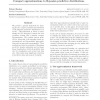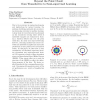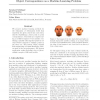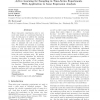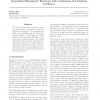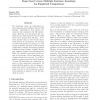99
Voted
ICML
2005
IEEE
16 years 1 months ago
2005
IEEE
In genomic sequence analysis tasks like splice site recognition or promoter identification, large amounts of training sequences are available, and indeed needed to achieve suffici...
90
Voted
ICML
2005
IEEE
16 years 1 months ago
2005
IEEE
We provide a general framework for learning precise, compact, and fast representations of the Bayesian predictive distribution for a model. This framework is based on minimizing t...
100
Voted
ICML
2005
IEEE
16 years 1 months ago
2005
IEEE
Due to its occurrence in engineering domains and implications for natural learning, the problem of utilizing unlabeled data is attracting increasing attention in machine learning....
106
Voted
ICML
2005
IEEE
16 years 1 months ago
2005
IEEE
We present a new subgoal-based method for automatically creating useful skills in reinforcement learning. Our method identifies subgoals by partitioning local state transition gra...
74
Voted
ICML
2005
IEEE
16 years 1 months ago
2005
IEEE
We propose machine learning methods for the estimation of deformation fields that transform two given objects into each other, thereby establishing a dense point to point correspo...
82
Voted
ICML
2005
IEEE
2005
IEEE
Active learning for sampling in time-series experiments with application to gene expression analysis
16 years 1 months ago
Many time-series experiments seek to estimate some signal as a continuous function of time. In this paper, we address the sampling problem for such experiments: determining which ...
87
Voted
ICML
2005
IEEE
16 years 1 months ago
2005
IEEE
Maximum Margin Matrix Factorization (MMMF) was recently suggested (Srebro et al., 2005) as a convex, infinite dimensional alternative to low-rank approximations and standard facto...
109
click to vote
ICML
2005
IEEE
16 years 1 months ago
2005
IEEE
This paper extends previous work on skewing, an approach to problematic functions in decision tree induction. The previous algorithms were applicable only to functions of binary v...
94
Voted
ICML
2005
IEEE
16 years 1 months ago
2005
IEEE
We introduce an expectation maximizationtype (EM) algorithm for maximum likelihood optimization of conditional densities. It is applicable to hidden variable models where the dist...
100
click to vote
ICML
2005
IEEE
16 years 1 months ago
2005
IEEE
We empirically study the relationship between supervised and multiple instance (MI) learning. Algorithms to learn various concepts have been adapted to the MI representation. Howe...

